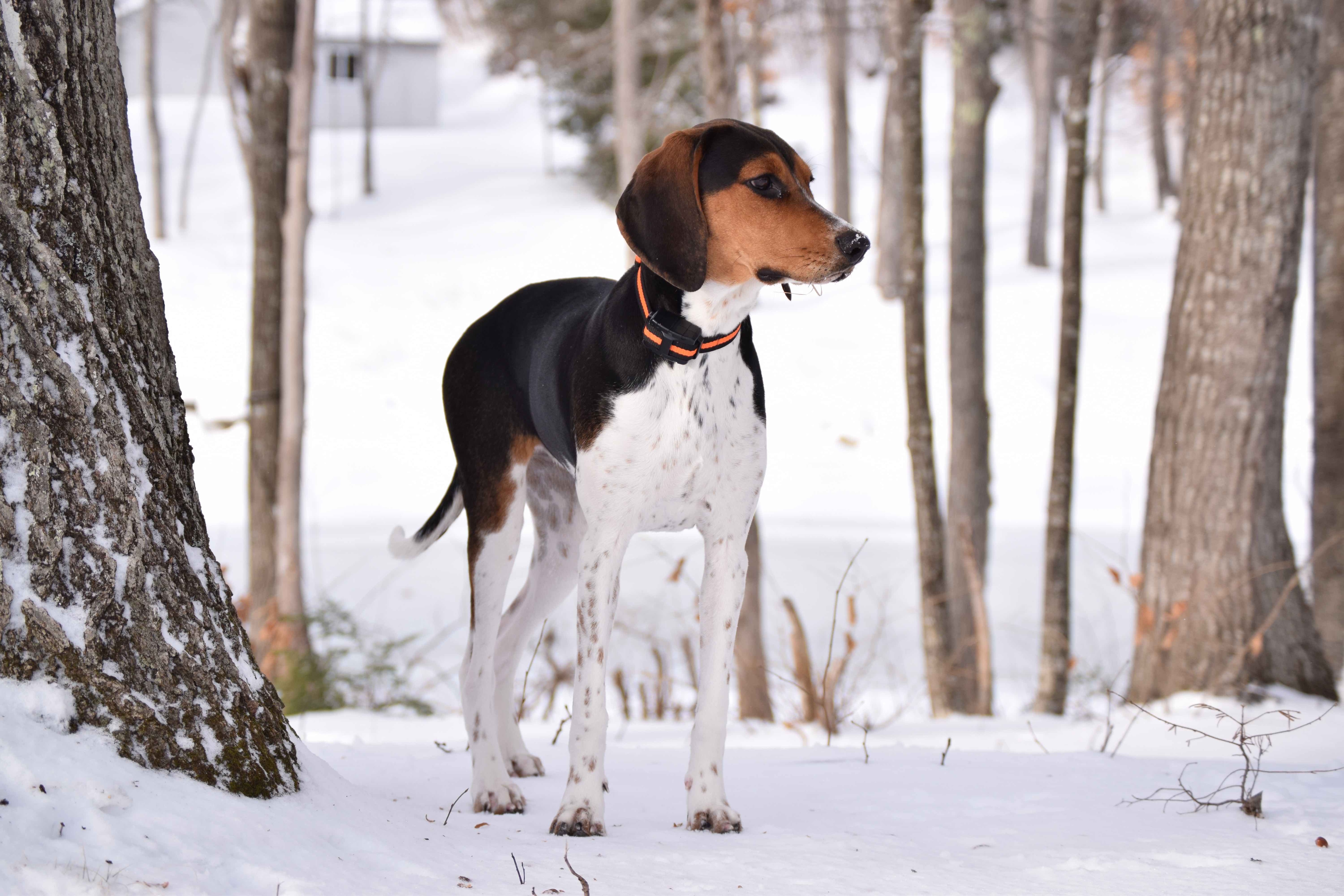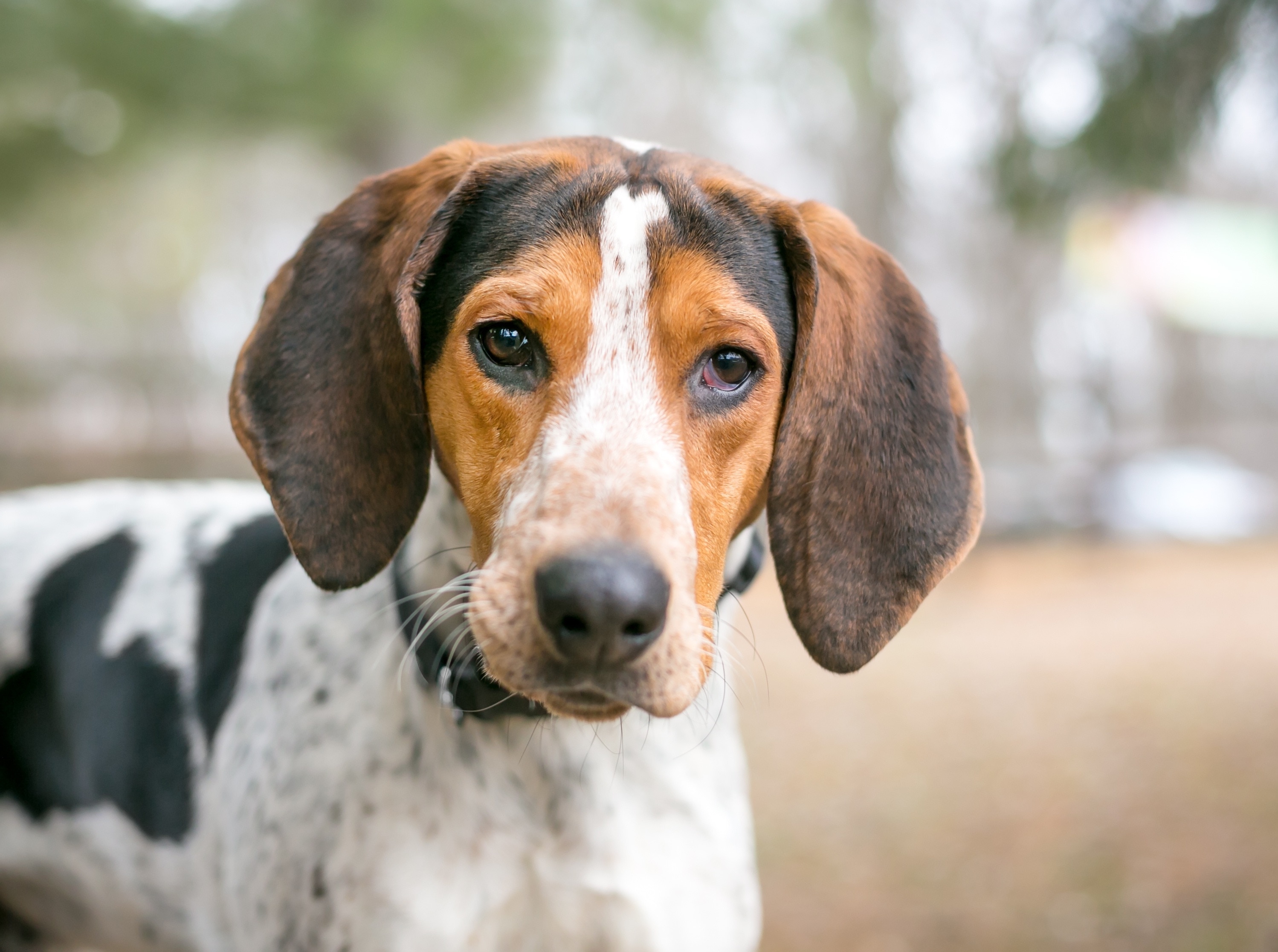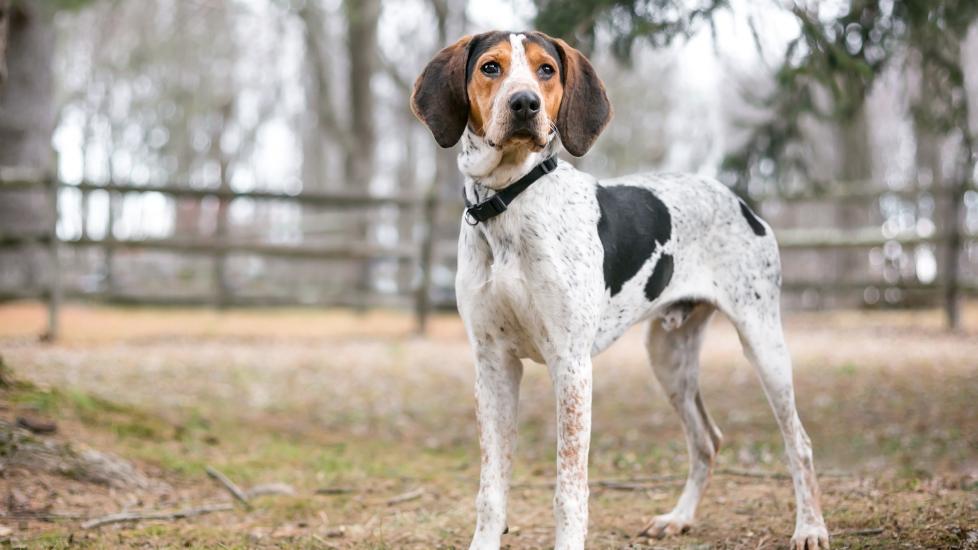Treeing Walker Coonhound
The Treeing Walker Coonhound is a high-energy, intelligent, and good-natured hound dog. Descended from the American Foxhound, Treeing Walker Coonhounds have been bred since the mid-1700s to help hunters track and isolate game in the forest, most notably raccoons. A Virginian named Thomas Walker is credited with the breed’s development in the Appalachian Mountains.
They were recognized by the United Kennel Club (UKC) in 1945 and the American Kennel Club (AKC) in 2012. While primarily a working breed, the Treeing Walker Coonhound’s friendly disposition and trainability make them a good family dog in the right home.
Caring for a Treeing Walker Coonhound
The Treeing Walker Coonhound is a medium to large hound that’s 20–25 inches tall at the shoulder and 50–70 pounds full grown. They have a short coat that’s easy to maintain and doesn’t require frequent grooming. As with any hound, attention should be given to their large, floppy ears to avoid ear infections.
Coonhounds do best in an active household, though you’ll often find them napping on the couch. These muscular dogs are bred for endurance and need more than a short walk every day. Take them with you on runs, hikes, or out hunting.
Though smart and very trainable, Treeing Walker Coonhounds were bred to be independent workers and can have a strong will. Their loud voices mean you’ll be alerted to approaching mail carriers (or even passing neighborhood squirrels), though Coonhounds are usually friendly with people and other dogs when well-socialized. They will follow their strong nose and track quarry for long distances, so a fenced yard is preferable if you can’t monitor their exercise closely.
While primarily a working breed, the Treeing Walker Coonhound’s friendly disposition and trainability make them a good family dog in the right home.
Treeing Walker Coonhound Health Issues
The average Treeing Walker Coonhound lifespan is 12–13 years, and they’re considered a breed with few genetic health concerns. That said, there are some conditions of which pet parents of any large hound should be aware.
Hip Dysplasia
Hip dysplasia is a genetic disorder, usually found in large-breed dogs, where the hip socket forms abnormally and results in an unstable joint. This instability leads to abnormal movement of the joint, leading to scar tissue, inflammation, and pain.
The most common symptom of hip dysplasia is pain in one or both hind limbs. This can be seen as limping, stiffness when getting up, or even just a change in how a dog walks or runs. Diagnosis of hip dysplasia requires X-ray imaging under sedation, and veterinarians can find evidence of dysplasia in dogs as young as 16 weeks.
Most cases of hip dysplasia are treated medically by keeping dogs in slim body condition; using joint supplements and laser therapy to protect joints; and giving pain medications and anti-inflammatories to keep dogs comfortable. Severe cases of hip dysplasia can benefit from surgery.
Hypothyroidism
The thyroid is a gland in the neck that produces hormones that control metabolism. Some dogs are genetically predisposed to produce antibodies against this gland (autoimmune thyroiditis), which destroys the gland and makes them unable to produce as much thyroid hormone.
Clinical signs of thyroid disease in dogs include weight gain, hair loss, skin infections, and behavior changes. Rarely, dogs will present with neurologic signs, such as facial nerve paralysis and even seizures.
Thyroid disease is diagnosed with blood tests looking for thyroid hormone levels and antibody levels. Treatment is lifelong medication, which most dogs tolerate very well.
Ear Infections
Those floppy hound ears are prone to trapping moisture and debris, leading to ear infections (otitis externa). Routine cleaning with a cotton ball and a pH-balanced cleanser meant for dog ears can reduce the risk of infections, which veterinarians often have to treat with topical medications.
Frequent ear infections may also be a sign of allergies. If routine cleaning is not preventing infections in your dog, discuss this with your vet.
What To Feed a Treeing Walker Coonhound
Companion Treeing Walker Coonhounds don’t have specific dietary requirements and can be fed any well-balanced dog foods approved by the Association of American Feed Control Officials (AAFCO).
Working dogs may benefit from a higher-calorie sport diet if they are not maintaining weight on a normal maintenance diet, though it’s rare that your Coonhound will need this. You may feed wet and/or dry food according to your dog’s preference.
How To Feed a Treeing Walker Coonhound
This breed should have no issue eating two to three well-portioned meals per day. Treeing Walker Coonhound puppies need to eat more frequent meals—about three or four per day. Consider a puzzle feeder for these very intelligent dogs to keep them from getting bored.
How Much Should You Feed a Treeing Walker Coonhound?
The amount to feed your Treeing Walker Coonhound depends on the brand and type of food you choose. Discuss your pup’s ideal calorie intake with your vet and monitor your dog’s weight and body condition.
Don’t forget to account for treats, dental chews, and training snacks in their total calorie count.
Nutritional Tips for Treeing Walker Coonhounds
Though a well-balanced maintenance diet should cover all of your Coonhound’s needs, very active dogs may benefit from joint support and omega-3 fatty acid supplementation. Your veterinarian can help determine if any products would benefit your dog.
Behavior and Training Tips for Treeing Walker Coonhounds
Treeing Walker Coonhound Personality and Temperament

Treeing Walker Coonhounds are generally even-tempered, trainable, happy companions. They are very people-oriented and known to be good with children and other dogs, especially when well-socialized and with proper introductions.
Because of their long history as hunting dogs, they should be introduced carefully to cats and other small animals because of their prey drive. This breed may see smaller animals as something to chase.
Treeing Walker Coonhound Behavior
Treeing Walker Coonhounds are bred for hunting, and some of the traits that make them great hunting dogs may be unwanted in certain homes. Tracking raccoons through the woods requires endurance and athleticism, which means these dogs need plenty of exercise, with daily hour-long walks as a bare minimum. They are great partners for running and hiking multiple times per week. Field trials are a great way to stimulate your coonhound’s natural desire to hunt and track, even if you aren’t a hunter yourself.
Coonhounds are prized for their howling bark, or bay, which lets the hunter know they’ve cornered their quarry. Needless to say, neighbors in an apartment complex may not appreciate these vocal dogs.
Treeing Walker Coonhound Training
Treeing Walkers are intelligent and eager to please, though their exuberance may require extra patience. They are described as slow to mature, so that high-energy puppy stage may last until they are 2 years old (or even longer).
Begin socializing your puppy early, at 8–10 weeks, so they develop confidence in new situations. This, along with proper positive reinforcement training, will help you end up with a reliable companion.
Fun Activities for Treeing Walker Coonhounds
-
Field trials
-
Water races
Treeing Walker Coonhound Grooming Guide
Treeing Walker Coonhounds have short, smooth, low-maintenance coats that do not require frequent grooming.
Skin Care
Treeing Walkers do not have unique skin care needs. Contact your veterinarian if you notice changes in your dog’s skin.
Coat Care
Treeing Walker Coonhounds have short and smooth haircoats that are low-maintenance. Bathing monthly (and also when they are dirty) with a shampoo made for dogs is sufficient for keeping your pup clean and healthy. Coonhounds are moderate shedders and benefit from weekly brushing.
Eye Care
Treeing Walker Coonhounds do not have unique eye care needs. If you notice changes in your dog’s eyes, such as cloudiness, redness, or discharge, call your vet.
Ear Care
Treeing Walker Coonhounds have long, floppy ears and are more prone to ear infections than other dogs. Inspecting the ears frequently and cleaning them at least once a week with an appropriate ear cleaner is enough to prevent ear infections in dogs without allergies.
If, despite routine ear cleanings, your Treeing Walker Coonhound keeps developing ear infections, talk to your vet about allergies your dog may have.
Considerations for Pet Parents

Though bred primarily as a working dog, Treeing Walker Coonhounds can make excellent companions for a family with the time and space to give them the attention and exercise they need. Aside from routine ear cleanings, they require minimal maintenance and are not prone to many health issues.
Even when well-trained, Treeing Walker Coonhounds are very vocal and not well-suited to having close neighbors, but they usually do well with children and other dogs. Be cautious when introducing them to smaller animals and cats, as they do like to chase them.
After an active day, these hounds like nothing better than to curl up with their family and relax.
Treeing Walker Coonhound FAQs
Are Treeing Walker Coonhounds high-energy?
Treeing Walker Coonhounds are playful, active dogs that require at least moderate exercise to stay happy and healthy. Most dogs of this breed will do best with regular activity that mimics the endurance running and tracking they were bred to perform, such as hiking or agility trials.
Do Treeing Walker Coonhounds like to cuddle?
Treeing Walker Coonhounds are social and most enjoy snuggling up with their favorite human after a day of activity.
What are Treeing Walker Coonhounds best known for?
Treeing Walker Coonhounds are best known for their remarkable ability to quickly track hunting quarry, and for their unique, bugle-like bark that can carry for miles.
Featured Image: Adobe/Mary Swift
